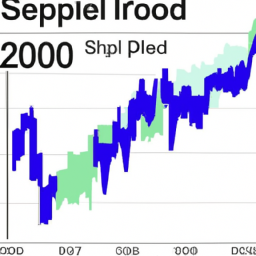The S&P 500 was up 3.5% in March. This may come as a surprise, given that two major banks went under and another is in the process of doing so. However, the index has been on a steady upward trend since the pandemic-induced market crash in March 2020. If you're looking to invest in the S&P 500, now is a great time to do so.
Before we get into the nitty-gritty of how to invest in the S&P 500, let's first understand what it is. The S&P 500 is an index of 500 large-cap stocks that are listed on the New York Stock Exchange (NYSE) and the NASDAQ. These stocks represent some of the largest and most established companies in the United States, such as Apple, Microsoft, and Amazon.
The first step to investing in the S&P 500 is to open a brokerage account. A brokerage account is an investment account that allows you to buy and sell stocks, bonds, and other securities. There are many online brokerage firms available, such as Charles Schwab, Fidelity, and TD Ameritrade. You'll need to do your research and choose the one that's right for you.
Once you have a brokerage account, you'll need to decide how you want to invest in the S&P 500. One option is to buy individual stocks. This can be a good option if you have the time and expertise to research individual companies and select the ones that you believe will perform well. However, this can be a risky strategy, as individual stocks can be volatile and subject to sudden price swings.
Another option is to invest in an S&P 500 index fund. An index fund is a type of mutual fund or exchange-traded fund (ETF) that tracks the performance of a specific index, such as the S&P 500. This is a more passive investment strategy that allows you to invest in a diversified portfolio of stocks without having to research individual companies.
If you decide to invest in an S&P 500 index fund, you'll need to choose which one to invest in. There are many options available, but some of the most popular include the Vanguard 500 Index Fund (VFINX), the SPDR S&P 500 ETF (SPY), and the iShares Core S&P 500 ETF (IVV). Each of these funds has its own unique features and fees, so be sure to do your research before making a decision.
Once you've chosen an S&P 500 index fund, you'll need to decide how much to invest. The amount you invest will depend on your personal financial situation and investment goals. Some experts recommend investing at least 10% of your portfolio in the S&P 500, while others suggest investing up to 50% or more.
When investing in the S&P 500, it's important to remember that this is a long-term investment strategy. The stock market can be volatile in the short term, and there will be ups and downs along the way. However, over the long term, the S&P 500 has historically delivered solid returns.
If you're looking to maximize your returns, you may want to consider dollar-cost averaging. This is a strategy in which you invest a fixed amount of money at regular intervals, such as once a month. This can help you take advantage of market downturns by buying more shares when prices are low and fewer shares when prices are high.
In addition to investing in an S&P 500 index fund, you may also want to consider investing in individual stocks that are part of the index. Some of the top-performing stocks in the index include Apple (AAPL), Microsoft (MSFT), and Amazon (AMZN). However, be sure to do your research and select stocks that fit your investment strategy and risk tolerance.
In conclusion, investing in the S&P 500 can be a great way to grow your wealth over the long term. Whether you choose to invest in an S&P 500 index fund or individual stocks, be sure to do your research, diversify your portfolio, and invest for the long term.
Ticker: VFINX, SPY, IVV, AAPL, MSFT, AMZN.
